Deck 10: Cell Division
Question
Question
Question
Question
Question
Question
Question
Question
Question
Question
Question
Question
Question
Question
Question
Question
Question
Question
Question
Question
Question
Question
Question
Question
Question
Question
Question
Question
Question
Question
Question
Question
Question
Question
Question
Question
Question
Question
Question
Question
Question
Question
Question
Question
Question
Question
Question
Question
Question
Question
Question
Question
Question
Question
Question
Question
Question
Question
Question
Question
Question
Question
Question
Question
Question
Question
Question
Question
Question
Question
Question
Question
Question
Question
Question
Question
Question
Question
Question
Question

Unlock Deck
Sign up to unlock the cards in this deck!
Unlock Deck
Unlock Deck
1/89
Play
Full screen (f)
Deck 10: Cell Division
1
In what way(s)would the karyotype shown below be different if the material used to prepare the analysis were an egg or sperm cell? 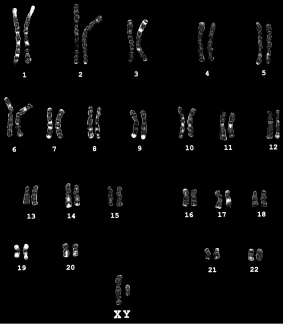
A)The total number of chromosomes would be 23 in this example.
B)No homologous pairing would be possible.
C)The sex chromosome would be represented by a single X or a single Y rather than a pair.
D)all of the above

A)The total number of chromosomes would be 23 in this example.
B)No homologous pairing would be possible.
C)The sex chromosome would be represented by a single X or a single Y rather than a pair.
D)all of the above
D
2
During the S phase, the cell
A)duplicates its DNA.
B)grows in size to prepare for DNA synthesis.
C)completes its preparation for mitosis.
D)rests between divisions.
A)duplicates its DNA.
B)grows in size to prepare for DNA synthesis.
C)completes its preparation for mitosis.
D)rests between divisions.
A
3
The process of mitosis is thought to have evolved from binary fission. What similarities exist between these processes?
A)The DNA being separated is attached to a membrane during both processes.
B)Both processes involve the separation of more than one piece of DNA.
C)Both processes include DNA segregation.
D)DNA must be tightly packaged into chromosomes before either process can begin.
A)The DNA being separated is attached to a membrane during both processes.
B)Both processes involve the separation of more than one piece of DNA.
C)Both processes include DNA segregation.
D)DNA must be tightly packaged into chromosomes before either process can begin.
C
4
Sexual and asexual reproduction can both offer distinct advantages under certain circumstances. In which of the following situations would asexual reproduction be disadvantageous?
A)Decomposers discover a dolphin carcass that had recently drifted to the ocean floor.
B)A persistently cooling climate results in a significant increase in average winter snow depth.
C)A cut breaches the defensive ability of the skin and infectious pathogens invade the injury.
D)Coastal currents, water temperature, nutrient concentrations, and light intensity temporarily combine to produce ideal growth conditions for marine phytoplankton.
A)Decomposers discover a dolphin carcass that had recently drifted to the ocean floor.
B)A persistently cooling climate results in a significant increase in average winter snow depth.
C)A cut breaches the defensive ability of the skin and infectious pathogens invade the injury.
D)Coastal currents, water temperature, nutrient concentrations, and light intensity temporarily combine to produce ideal growth conditions for marine phytoplankton.

Unlock Deck
Unlock for access to all 89 flashcards in this deck.
Unlock Deck
k this deck
5
Which of the following statements is not generally true?
A)As an organism matures, it needs more cells.
B)As an organism matures, it needs different kinds of cells.
C)As an organism matures, it needs to replace the DNA in each of its cells.
D)As an organism matures, it needs to replace worn-out cells.
A)As an organism matures, it needs more cells.
B)As an organism matures, it needs different kinds of cells.
C)As an organism matures, it needs to replace the DNA in each of its cells.
D)As an organism matures, it needs to replace worn-out cells.

Unlock Deck
Unlock for access to all 89 flashcards in this deck.
Unlock Deck
k this deck
6
What feature(s)distinguish an embryo from a zygote?
A)The cells of an embyro are diploid, whereas those of the zygote are haploid.
B)A zygote consists of a single cell, whereas an embryo is multicellular.
C)An embryo has differentiated to the extent that rudimentary organs are present, whereas a zygote's cells are still undifferentiated.
D)both a and c
A)The cells of an embyro are diploid, whereas those of the zygote are haploid.
B)A zygote consists of a single cell, whereas an embryo is multicellular.
C)An embryo has differentiated to the extent that rudimentary organs are present, whereas a zygote's cells are still undifferentiated.
D)both a and c

Unlock Deck
Unlock for access to all 89 flashcards in this deck.
Unlock Deck
k this deck
7
Which of the following must occur before cell division begins?
A)duplication of the nucleus
B)DNA synthesis
C)cytokinesis
D)DNA segregation
A)duplication of the nucleus
B)DNA synthesis
C)cytokinesis
D)DNA segregation

Unlock Deck
Unlock for access to all 89 flashcards in this deck.
Unlock Deck
k this deck
8
Cell division, the climax of the cell cycle, consists of
A)chromosome replication and separation.
B)the breakup of the nucleus at the metaphase plate.
C)cytokinesis plus mitosis or meiosis.
D)the formation of a new karyotype.
A)chromosome replication and separation.
B)the breakup of the nucleus at the metaphase plate.
C)cytokinesis plus mitosis or meiosis.
D)the formation of a new karyotype.

Unlock Deck
Unlock for access to all 89 flashcards in this deck.
Unlock Deck
k this deck
9
Sexual reproduction results in many benefits for a population, but not without some inconvenience; for example,
A)each participant must locate an appropriate mate.
B)the time required for sexual reproduction may mean that short-term opportunities for population growth are missed.
C)some genetic combinations may be disadvantageous and the effort invested in producing offspring wasted.
D)all of the above
A)each participant must locate an appropriate mate.
B)the time required for sexual reproduction may mean that short-term opportunities for population growth are missed.
C)some genetic combinations may be disadvantageous and the effort invested in producing offspring wasted.
D)all of the above

Unlock Deck
Unlock for access to all 89 flashcards in this deck.
Unlock Deck
k this deck
10
Some daughter cells are described as clones; for this description to be appropriate, the daughter cells must
A)show the same differentiation characteristics as the parent cell.
B)separate from one another and experience an independent existence.
C)contain a set of DNA that is identical to that of the parent cell.
D)have been produced by meiotic cell division.
A)show the same differentiation characteristics as the parent cell.
B)separate from one another and experience an independent existence.
C)contain a set of DNA that is identical to that of the parent cell.
D)have been produced by meiotic cell division.

Unlock Deck
Unlock for access to all 89 flashcards in this deck.
Unlock Deck
k this deck
11
In what way(s)does a human somatic cell differ from a human gamete?
A)Somatic cells are diploid (2n), whereas gametes are haploid (n).
B)Somatic cells are created by mitosis, whereas gametes are created by meiosis.
C)Somatic cells differentiate into at least 220 cell types, whereas only two types of gametes exist.
D)all of the above
A)Somatic cells are diploid (2n), whereas gametes are haploid (n).
B)Somatic cells are created by mitosis, whereas gametes are created by meiosis.
C)Somatic cells differentiate into at least 220 cell types, whereas only two types of gametes exist.
D)all of the above

Unlock Deck
Unlock for access to all 89 flashcards in this deck.
Unlock Deck
k this deck
12
Which set of symbols represents the stages of interphase?
A)G0, G1, and G2
B)S1, S2, and G0
C)G0, G1, and S
D)S, G1, and G2
A)G0, G1, and G2
B)S1, S2, and G0
C)G0, G1, and S
D)S, G1, and G2

Unlock Deck
Unlock for access to all 89 flashcards in this deck.
Unlock Deck
k this deck
13
Which of the following choices states a correct reason why the process of cell division is different for prokaryotic than for eukaryotic cells?
A)Prokaryotes have a circular DNA molecule.
B)Prokaryotic cells do not undergo cell division.
C)Prokaryotic cells are larger than eukaryotic cells.
D)Prokaryotic DNA contains different bases from those in eukaryotic DNA.
A)Prokaryotes have a circular DNA molecule.
B)Prokaryotic cells do not undergo cell division.
C)Prokaryotic cells are larger than eukaryotic cells.
D)Prokaryotic DNA contains different bases from those in eukaryotic DNA.

Unlock Deck
Unlock for access to all 89 flashcards in this deck.
Unlock Deck
k this deck
14
An unduplicated chromosome contains
A)two sister chromatids.
B)a single molecule of DNA combined with a large number of proteins.
C)the cell's karyotype.
D)its own spindle poles.
A)two sister chromatids.
B)a single molecule of DNA combined with a large number of proteins.
C)the cell's karyotype.
D)its own spindle poles.

Unlock Deck
Unlock for access to all 89 flashcards in this deck.
Unlock Deck
k this deck
15
Which of the following statements about cell division is correct?
A)It is the process by which organisms grow and maintain their tissues.
B)It is no longer necessary once an organism reaches maturity.
C)It occurs in two sequential stages in all cells: mitosis and meiosis.
D)It is the process by which fertilization occurs.
A)It is the process by which organisms grow and maintain their tissues.
B)It is no longer necessary once an organism reaches maturity.
C)It occurs in two sequential stages in all cells: mitosis and meiosis.
D)It is the process by which fertilization occurs.

Unlock Deck
Unlock for access to all 89 flashcards in this deck.
Unlock Deck
k this deck
16
The G₀ phase of the cell cycle is distinguished by
A)an active preparation for DNA synthesis.
B)a doubling of chromosomes.
C)an absence of preparation for DNA synthesis.
D)the appearance of a metaphase plate.
A)an active preparation for DNA synthesis.
B)a doubling of chromosomes.
C)an absence of preparation for DNA synthesis.
D)the appearance of a metaphase plate.

Unlock Deck
Unlock for access to all 89 flashcards in this deck.
Unlock Deck
k this deck
17
Which of the following series correctly represents the levels of DNA packing from simplest to most dense?
A)DNA strand à chromatin à chromosomes
B)chromosome à chromatin à DNA strand
C)chromosome à chromatin à DNA
D)chromatin à DNA à centromere
A)DNA strand à chromatin à chromosomes
B)chromosome à chromatin à DNA strand
C)chromosome à chromatin à DNA
D)chromatin à DNA à centromere

Unlock Deck
Unlock for access to all 89 flashcards in this deck.
Unlock Deck
k this deck
18
A single cell grows into a multicellular organism by the process of
A)mitosis.
B)meiosis.
C)fertilization.
D)duplication.
A)mitosis.
B)meiosis.
C)fertilization.
D)duplication.

Unlock Deck
Unlock for access to all 89 flashcards in this deck.
Unlock Deck
k this deck
19
Cancers are groups of cells that divide rapidly and uncontrollably. Thus cancer cells
A)are always in the G0 phase.
B)never enter the cell cycle.
C)have a relatively short G1 phase and ignore the G1 and G2 checkpoints.
D)are stuck at the metaphase plate.
A)are always in the G0 phase.
B)never enter the cell cycle.
C)have a relatively short G1 phase and ignore the G1 and G2 checkpoints.
D)are stuck at the metaphase plate.

Unlock Deck
Unlock for access to all 89 flashcards in this deck.
Unlock Deck
k this deck
20
The illustration below shows a summary of the events in the life cycle of a human. Which of the lettered transitions or events require mitosis? 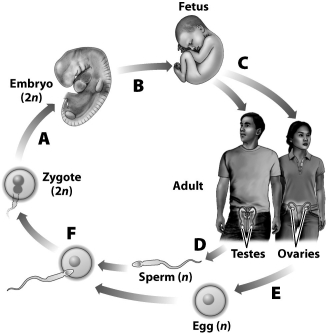
A)all but F
B)A, B, and C
C)D and E
D)F only

A)all but F
B)A, B, and C
C)D and E
D)F only

Unlock Deck
Unlock for access to all 89 flashcards in this deck.
Unlock Deck
k this deck
21
Which of the following could be determined from a karyotype?
A)the gender of the individual that provided the sample
B)whether the source of the sample was from a nonhuman species
C)whether the source of the sample was from a somatic cell or a gamete
D)all of the above
A)the gender of the individual that provided the sample
B)whether the source of the sample was from a nonhuman species
C)whether the source of the sample was from a somatic cell or a gamete
D)all of the above

Unlock Deck
Unlock for access to all 89 flashcards in this deck.
Unlock Deck
k this deck
22
The mitotic spindle is made of
A)centrosomes.
B)chromosomes.
C)kinetochores.
D)microtubules.
A)centrosomes.
B)chromosomes.
C)kinetochores.
D)microtubules.

Unlock Deck
Unlock for access to all 89 flashcards in this deck.
Unlock Deck
k this deck
23
Some human cells, skeletal muscle for example, are multinucleated and originate when uninucleated cells fuse. What cell division process alone could produce a multinucleated cell?
A)a cell experiencing mitosis but not cytokinesis
B)a cell experiencing cytokinesis but not mitosis
C)a cell arresting after meiosis I
D)fertilization of a haploid egg by a diploid sperm
A)a cell experiencing mitosis but not cytokinesis
B)a cell experiencing cytokinesis but not mitosis
C)a cell arresting after meiosis I
D)fertilization of a haploid egg by a diploid sperm

Unlock Deck
Unlock for access to all 89 flashcards in this deck.
Unlock Deck
k this deck
24
A drug inhibits the formation of microtubules. This drug is added to a culture of cells during G₂. How might this drug affect the cell division?
A)Cytokinesis could not occur.
B)The nuclear envelope would be unable to break down.
C)DNA synthesis would not occur.
D)The spindle apparatus would be unable to form.
A)Cytokinesis could not occur.
B)The nuclear envelope would be unable to break down.
C)DNA synthesis would not occur.
D)The spindle apparatus would be unable to form.

Unlock Deck
Unlock for access to all 89 flashcards in this deck.
Unlock Deck
k this deck
25
The completion of the physical division of the parent cell during the last stage of mitosis is known as
A)centrosome formation.
B)G0.
C)cytokinesis.
D)meiosis.
A)centrosome formation.
B)G0.
C)cytokinesis.
D)meiosis.

Unlock Deck
Unlock for access to all 89 flashcards in this deck.
Unlock Deck
k this deck
26
Which of the following is true of the chromosomes in a homologous pair?
A)They both came from the organism's mother.
B)They both came from the organism's father.
C)One chromosome came from each of the organism's parents.
D)Neither chromosome came from the organism's parents.
A)They both came from the organism's mother.
B)They both came from the organism's father.
C)One chromosome came from each of the organism's parents.
D)Neither chromosome came from the organism's parents.

Unlock Deck
Unlock for access to all 89 flashcards in this deck.
Unlock Deck
k this deck
27
During anaphase, daughter chromosomes
A)are condensed into chromatin.
B)move toward opposite spindle poles.
C)form homologous pairs.
D)move toward the same spindle pole.
A)are condensed into chromatin.
B)move toward opposite spindle poles.
C)form homologous pairs.
D)move toward the same spindle pole.

Unlock Deck
Unlock for access to all 89 flashcards in this deck.
Unlock Deck
k this deck
28
The successful union of one male and one female gamete forms a new single cell known as a
A)histone.
B)zygote.
C)vesicle.
D)gametocyte.
A)histone.
B)zygote.
C)vesicle.
D)gametocyte.

Unlock Deck
Unlock for access to all 89 flashcards in this deck.
Unlock Deck
k this deck
29
The microtubules that grow out from the centrosomes
A)pull the nuclear envelope apart.
B)pull the centrosomes together.
C)eventually become kinetochores.
D)eventually attach to centromeres.
A)pull the nuclear envelope apart.
B)pull the centrosomes together.
C)eventually become kinetochores.
D)eventually attach to centromeres.

Unlock Deck
Unlock for access to all 89 flashcards in this deck.
Unlock Deck
k this deck
30
Plants perform cytokinesis differently than animals because
A)plant cytokinesis takes place during interphase, but animal cytokinesis takes place in cell division.
B)plant chromosomes are more difficult to separate than animal chromosomes.
C)the rigid cell wall of the plant cell prevents the plasma membrane from pinching inward like it does in animal cells.
D)the centrosomes of plants do not replicate prior to cell division.
A)plant cytokinesis takes place during interphase, but animal cytokinesis takes place in cell division.
B)plant chromosomes are more difficult to separate than animal chromosomes.
C)the rigid cell wall of the plant cell prevents the plasma membrane from pinching inward like it does in animal cells.
D)the centrosomes of plants do not replicate prior to cell division.

Unlock Deck
Unlock for access to all 89 flashcards in this deck.
Unlock Deck
k this deck
31
Why must DNA be packed into chromosomes before mitosis or meiosis can occur?
A)In their unpacked state, the strands of DNA would be difficult to pull apart during cell division.
B)The zygote would be unable to live if the DNA were not packed into chromosomes.
C)We would be unable to see the karyotype if the DNA were not packed into chromosomes.
D)Some of the genes would escape during cell division if they were not packed tightly into chromosomes.
A)In their unpacked state, the strands of DNA would be difficult to pull apart during cell division.
B)The zygote would be unable to live if the DNA were not packed into chromosomes.
C)We would be unable to see the karyotype if the DNA were not packed into chromosomes.
D)Some of the genes would escape during cell division if they were not packed tightly into chromosomes.

Unlock Deck
Unlock for access to all 89 flashcards in this deck.
Unlock Deck
k this deck
32
Which of the following foods is most likely to contain haploid cells?
A)a sirloin steak
B)an apple
C)an egg
D)a stalk of celery
A)a sirloin steak
B)an apple
C)an egg
D)a stalk of celery

Unlock Deck
Unlock for access to all 89 flashcards in this deck.
Unlock Deck
k this deck
33
The goal of mitosis is to
A)form two equal daughter nuclei.
B)form chromatin strands.
C)loop chromatin into chromosomes.
D)package chromosomes into chromatin.
A)form two equal daughter nuclei.
B)form chromatin strands.
C)loop chromatin into chromosomes.
D)package chromosomes into chromatin.

Unlock Deck
Unlock for access to all 89 flashcards in this deck.
Unlock Deck
k this deck
34
The two sister chromatids of a single chromosome are held together by a
A)centrosome.
B)spindle fiber.
C)centromere.
D)chromatin.
A)centrosome.
B)spindle fiber.
C)centromere.
D)chromatin.

Unlock Deck
Unlock for access to all 89 flashcards in this deck.
Unlock Deck
k this deck
35
When examining the rapidly dividing cells of the onion root tip, you see a cell whose chromosomes are visible and are arranged in approximately the same size and shape as the nucleus. What stage of mitosis is this cell in?
A)metaphase
B)prophase
C)anaphase
D)telophase
A)metaphase
B)prophase
C)anaphase
D)telophase

Unlock Deck
Unlock for access to all 89 flashcards in this deck.
Unlock Deck
k this deck
36
Chromosomes are lined up at the middle of the cell during the _____ portion of cell division.
A)metaphase
B)anaphase
C)telophase
D)interphase
A)metaphase
B)anaphase
C)telophase
D)interphase

Unlock Deck
Unlock for access to all 89 flashcards in this deck.
Unlock Deck
k this deck
37
After a single cell undergoes meiosis, how many new cells will be produced?
A)2
B)4
C)12
D)16
A)2
B)4
C)12
D)16

Unlock Deck
Unlock for access to all 89 flashcards in this deck.
Unlock Deck
k this deck
38
When examining the rapidly dividing cells of a fish embryo, you notice a cell that seems to contain two nuclei. The middle of the cell is pinched inward. This cell must be in _____ of mitosis.
A)prophase
B)telophase
C)metaphase
D)anaphase
A)prophase
B)telophase
C)metaphase
D)anaphase

Unlock Deck
Unlock for access to all 89 flashcards in this deck.
Unlock Deck
k this deck
39
Only meiosis could lead to the production of new
A)skin cells.
B)brain cells.
C)sperm cells.
D)liver cells.
A)skin cells.
B)brain cells.
C)sperm cells.
D)liver cells.

Unlock Deck
Unlock for access to all 89 flashcards in this deck.
Unlock Deck
k this deck
40
At the completion of mitosis, the nucleus of a human somatic cell has _____ chromosomes.
A)23
B)46
C)92
D)184
A)23
B)46
C)92
D)184

Unlock Deck
Unlock for access to all 89 flashcards in this deck.
Unlock Deck
k this deck
41
The bivalents of homologous chromosomes undergo crossing-over. What is the significance of this process?
A)Two copies of the same chromosome are allowed to become part of the same gamete.
B)The resulting gametes will have different gene combinations than their parent cells' gene combinations.
C)The bivalent chromosomes are able to exchange genetic material with other pairs of chromosomes.
D)The gametes that are produced will have twice as many chromosomes as the parent cells had.
A)Two copies of the same chromosome are allowed to become part of the same gamete.
B)The resulting gametes will have different gene combinations than their parent cells' gene combinations.
C)The bivalent chromosomes are able to exchange genetic material with other pairs of chromosomes.
D)The gametes that are produced will have twice as many chromosomes as the parent cells had.

Unlock Deck
Unlock for access to all 89 flashcards in this deck.
Unlock Deck
k this deck
42
The fact that DNA is distributed into homologous pairs allows
A)cells to reduce their chromosome number by half during meiosis.
B)a cell to begin meiosis with only half of its DNA.
C)sex chromosomes to exist in some cells.
D)microtubules to attach to only half of the chromosomes.
A)cells to reduce their chromosome number by half during meiosis.
B)a cell to begin meiosis with only half of its DNA.
C)sex chromosomes to exist in some cells.
D)microtubules to attach to only half of the chromosomes.

Unlock Deck
Unlock for access to all 89 flashcards in this deck.
Unlock Deck
k this deck
43
Gametes are produced by meiosis rather than mitosis because
A)mitosis would produce too many sister cells.
B)meiosis reduces the chromosome number so that zygotes produced will have one full genome.
C)meiosis doubles the chromosome number so that each gamete has twice the usual number of genes.
D)meiosis ensures that the gametes are identical to the cell that produced them.
A)mitosis would produce too many sister cells.
B)meiosis reduces the chromosome number so that zygotes produced will have one full genome.
C)meiosis doubles the chromosome number so that each gamete has twice the usual number of genes.
D)meiosis ensures that the gametes are identical to the cell that produced them.

Unlock Deck
Unlock for access to all 89 flashcards in this deck.
Unlock Deck
k this deck
44
The reduction division of meiosis has occurred when
A)bivalents are cut in half by proteins in their centromeres.
B)half of the bivalents line up on each side of the metaphase plate.
C)the first cell division of meiosis is complete.
D)the second cell division of meiosis is complete.
A)bivalents are cut in half by proteins in their centromeres.
B)half of the bivalents line up on each side of the metaphase plate.
C)the first cell division of meiosis is complete.
D)the second cell division of meiosis is complete.

Unlock Deck
Unlock for access to all 89 flashcards in this deck.
Unlock Deck
k this deck
45
The most critical stage of interphase for a cell that needs to undergo cell division is the ____________________ phase. If the cell does not complete this phase, it cannot undergo DNA segregation.

Unlock Deck
Unlock for access to all 89 flashcards in this deck.
Unlock Deck
k this deck
46
During mitosis, the number and shape of an organism's chromosomes become obvious. This set of identifiable chromosomes can be arranged into a diagram, or ____________________, of that organism.

Unlock Deck
Unlock for access to all 89 flashcards in this deck.
Unlock Deck
k this deck
47
During anaphase I of meiosis,
A)sister chromatids are pulled apart toward opposite poles.
B)each member of a bivalent moves toward a different pole.
C)all bivalents are pulled to the same pole.
D)paired homologues become attached to each other by microtubules.
A)sister chromatids are pulled apart toward opposite poles.
B)each member of a bivalent moves toward a different pole.
C)all bivalents are pulled to the same pole.
D)paired homologues become attached to each other by microtubules.

Unlock Deck
Unlock for access to all 89 flashcards in this deck.
Unlock Deck
k this deck
48
By the time a cell enters meiosis II, it has
A)become haploid.
B)reformed bivalents.
C)become temporarily diploid.
D)rejoined its maternal homologue.
A)become haploid.
B)reformed bivalents.
C)become temporarily diploid.
D)rejoined its maternal homologue.

Unlock Deck
Unlock for access to all 89 flashcards in this deck.
Unlock Deck
k this deck
49
The cell depicted below has a diploid number of 4 (2n = 4). 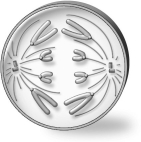
Assuming cell division started with a diploid cell, in what stage of what type of cell division is the cell?
A)anaphase of mitosis
B)anaphase I of meiosis
C)anaphase II of meiosis
D)Both a and c are possible.

Assuming cell division started with a diploid cell, in what stage of what type of cell division is the cell?
A)anaphase of mitosis
B)anaphase I of meiosis
C)anaphase II of meiosis
D)Both a and c are possible.

Unlock Deck
Unlock for access to all 89 flashcards in this deck.
Unlock Deck
k this deck
50
When appropriately prompted, diploid individuals of Ulva prolifera form spores that germinate to become haploid individuals. How might diploid individuals be created to complete the life cycle?
A)Haploid individuals meiotically produce egg and sperm cells, which subsequently fuse.
B)Some haploid individuals experience mitosis without cytokinesis followed by nuclear fusion.
C)Some individuals differentiate to become haploid gametes and then fuse to produce a diploid zygote.
D)Haploid individuals experience two sequential S phases in their cell cycle to reestablish the diploid state.
A)Haploid individuals meiotically produce egg and sperm cells, which subsequently fuse.
B)Some haploid individuals experience mitosis without cytokinesis followed by nuclear fusion.
C)Some individuals differentiate to become haploid gametes and then fuse to produce a diploid zygote.
D)Haploid individuals experience two sequential S phases in their cell cycle to reestablish the diploid state.

Unlock Deck
Unlock for access to all 89 flashcards in this deck.
Unlock Deck
k this deck
51
The parent cell shown below-left undergoes meiosis. In the box are three different gametes, numbered 1 through 3. 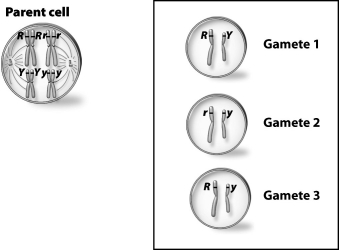
Which of these gametes could have come from this parent cell?
A)gamete 1
B)gamete 2
C)gamete 3
D)All of these gametes could have come from this parent cell.

Which of these gametes could have come from this parent cell?
A)gamete 1
B)gamete 2
C)gamete 3
D)All of these gametes could have come from this parent cell.

Unlock Deck
Unlock for access to all 89 flashcards in this deck.
Unlock Deck
k this deck
52
Lily plants sometimes have twice as many chromosomes per cell as their parent plants had. Which of the following explains how this might have happened?
A)The lily's sister chromatids failed to separate during meiosis.
B)The chromosome number of the lily went from 2n to 1n.
C)The lily gametes fused during mitosis.
D)The parent plant lost half of its chromosomes during mitosis.
A)The lily's sister chromatids failed to separate during meiosis.
B)The chromosome number of the lily went from 2n to 1n.
C)The lily gametes fused during mitosis.
D)The parent plant lost half of its chromosomes during mitosis.

Unlock Deck
Unlock for access to all 89 flashcards in this deck.
Unlock Deck
k this deck
53
DNA molecules are both exceptionally long (6 feet in humans)and exceptionally thin; to minimize breakage yet facilitate transcription, the DNA is wrapped around ____________________ to form a complex know as chromatin.

Unlock Deck
Unlock for access to all 89 flashcards in this deck.
Unlock Deck
k this deck
54
The cell depicted below has a diploid number of 8 (2n = 8). 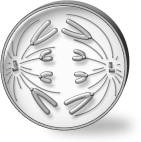
Assuming cell division started with a diploid cell, in what stage of what type of cell division is the cell?
A)anaphase of mitosis
B)anaphase I of meiosis
C)anaphase II of meiosis
D)Both a and c are possible.

Assuming cell division started with a diploid cell, in what stage of what type of cell division is the cell?
A)anaphase of mitosis
B)anaphase I of meiosis
C)anaphase II of meiosis
D)Both a and c are possible.

Unlock Deck
Unlock for access to all 89 flashcards in this deck.
Unlock Deck
k this deck
55
If a plant has a karyotype of 18 chromosomes, how many chromosomes would be present in each of its gametes?
A)36
B)18
C)9
D)6
A)36
B)18
C)9
D)6

Unlock Deck
Unlock for access to all 89 flashcards in this deck.
Unlock Deck
k this deck
56
Meiosis I is called a reduction division because the
A)need for mitosis is reduced.
B)time it takes for the cell to divide is reduced.
C)chromosome number goes from diploid to haploid.
D)cell size is reduced.
A)need for mitosis is reduced.
B)time it takes for the cell to divide is reduced.
C)chromosome number goes from diploid to haploid.
D)cell size is reduced.

Unlock Deck
Unlock for access to all 89 flashcards in this deck.
Unlock Deck
k this deck
57
Gametes contain _____ the genetic material that a generalized body cell contains.
A)half
B)the same amount of
C)twice
D)four times
A)half
B)the same amount of
C)twice
D)four times

Unlock Deck
Unlock for access to all 89 flashcards in this deck.
Unlock Deck
k this deck
58
DNA ____________________ is essential to cell division because it separates the two copies of DNA attached by the centromere.

Unlock Deck
Unlock for access to all 89 flashcards in this deck.
Unlock Deck
k this deck
59
How many sister chromatids are in a bivalent?
A)2
B)4
C)8
D)16
A)2
B)4
C)8
D)16

Unlock Deck
Unlock for access to all 89 flashcards in this deck.
Unlock Deck
k this deck
60
The parthenogenetic whiptail lizards of the desert Southwest create no new genetic combinations during crossing-over, like other animals, because
A)all the crosses are double, eventually restoring each chromosome to its original condition.
B)they possess no homologous chromosomes; crossing-over in this species occurs between genetically identical sister chromatids.
C)parthenogenetic species forgo meiosis I, when crossing-over normally occurs.
D)accumulated mutation within the species has modified the centromeres, disrupted the formation of a bivalent, and prevented crossing-over from taking place.
A)all the crosses are double, eventually restoring each chromosome to its original condition.
B)they possess no homologous chromosomes; crossing-over in this species occurs between genetically identical sister chromatids.
C)parthenogenetic species forgo meiosis I, when crossing-over normally occurs.
D)accumulated mutation within the species has modified the centromeres, disrupted the formation of a bivalent, and prevented crossing-over from taking place.

Unlock Deck
Unlock for access to all 89 flashcards in this deck.
Unlock Deck
k this deck
61
Interphase is an uneventful resting stage of the cell division cycle.

Unlock Deck
Unlock for access to all 89 flashcards in this deck.
Unlock Deck
k this deck
62
Many honeybee species are parthenogenic; unfertilized halpoid ____________________ develop to become haploid male bees called drones.

Unlock Deck
Unlock for access to all 89 flashcards in this deck.
Unlock Deck
k this deck
63
The mitotic spindle guides the movement of chromosomes during certain stages of mitosis.

Unlock Deck
Unlock for access to all 89 flashcards in this deck.
Unlock Deck
k this deck
64
Cytokinesis and mitosis are the same processes.

Unlock Deck
Unlock for access to all 89 flashcards in this deck.
Unlock Deck
k this deck
65
A zygote contains 16 chromosomes. The diploid number of this cell is ____________________ [2n = ?].

Unlock Deck
Unlock for access to all 89 flashcards in this deck.
Unlock Deck
k this deck
66
The four cells that result from meiosis are ____________________ rather than diploid.

Unlock Deck
Unlock for access to all 89 flashcards in this deck.
Unlock Deck
k this deck
67
The sequence of events in meiosis II is prophase II, ____________________, anaphase II, and telophase II, then cytokinesis.

Unlock Deck
Unlock for access to all 89 flashcards in this deck.
Unlock Deck
k this deck
68
New nuclei form during the anaphase portion of cell division.

Unlock Deck
Unlock for access to all 89 flashcards in this deck.
Unlock Deck
k this deck
69
Microtubules attach to plaques of protein called ____________________ on chromosomes.

Unlock Deck
Unlock for access to all 89 flashcards in this deck.
Unlock Deck
k this deck
70
The goal of ____________________ is to increase genetic diversity by creating a new diploid individual from haploid cells.

Unlock Deck
Unlock for access to all 89 flashcards in this deck.
Unlock Deck
k this deck
71
As the ____________________ separate during prophase, they determine opposite ends, or spindle poles, of a cell that is beginning mitosis.

Unlock Deck
Unlock for access to all 89 flashcards in this deck.
Unlock Deck
k this deck
72
At the end of telophase the cell is ready for physical division into two cells, a process called ____________________.

Unlock Deck
Unlock for access to all 89 flashcards in this deck.
Unlock Deck
k this deck
73
The spindle microtubules break down and new nuclear envelopes form during the ____________________ portion of mitosis.

Unlock Deck
Unlock for access to all 89 flashcards in this deck.
Unlock Deck
k this deck
74
Cytokinesis occurs during interphase.

Unlock Deck
Unlock for access to all 89 flashcards in this deck.
Unlock Deck
k this deck
75
The random distribution of chromosomes into daughter cells during ____________________ of meiosis is one way to create genetic diversity.

Unlock Deck
Unlock for access to all 89 flashcards in this deck.
Unlock Deck
k this deck
76
All cells in a human body undergo the process of meiosis.

Unlock Deck
Unlock for access to all 89 flashcards in this deck.
Unlock Deck
k this deck
77
With the possible exception of mutation, the two daughter cells produced in the illustration below are identical to one another.
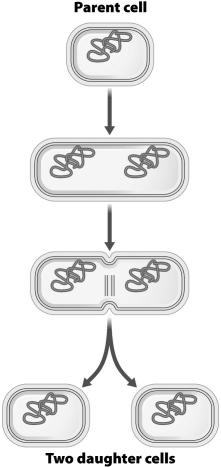


Unlock Deck
Unlock for access to all 89 flashcards in this deck.
Unlock Deck
k this deck
78
Chromosomes become visible during the ____________________ stage of mitosis.

Unlock Deck
Unlock for access to all 89 flashcards in this deck.
Unlock Deck
k this deck
79
The attachment of microtubules to the centromeres of chromosomes during ____________________ of mitosis sets the stage for the positioning of the chromosomes at the metaphase plate.

Unlock Deck
Unlock for access to all 89 flashcards in this deck.
Unlock Deck
k this deck
80
Sister chromatids are held together at a constriction point called a ____________________.

Unlock Deck
Unlock for access to all 89 flashcards in this deck.
Unlock Deck
k this deck



